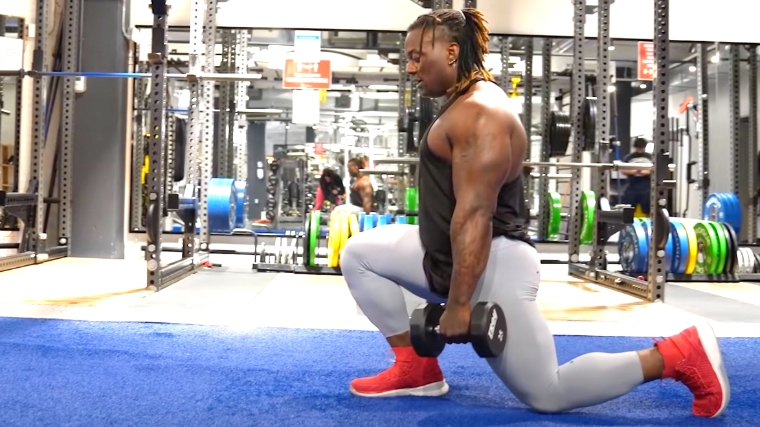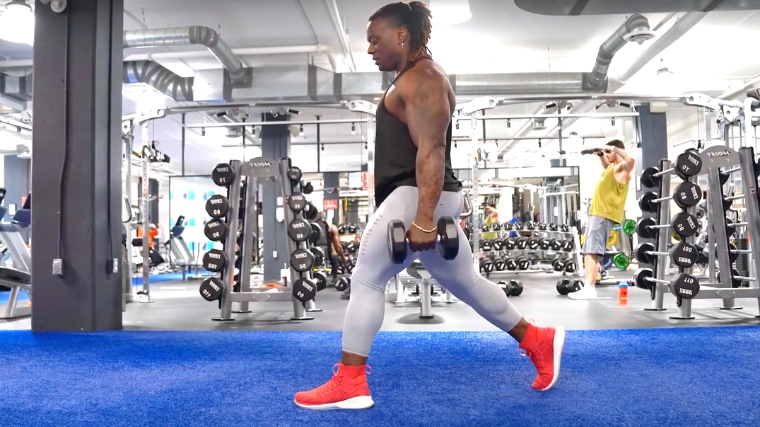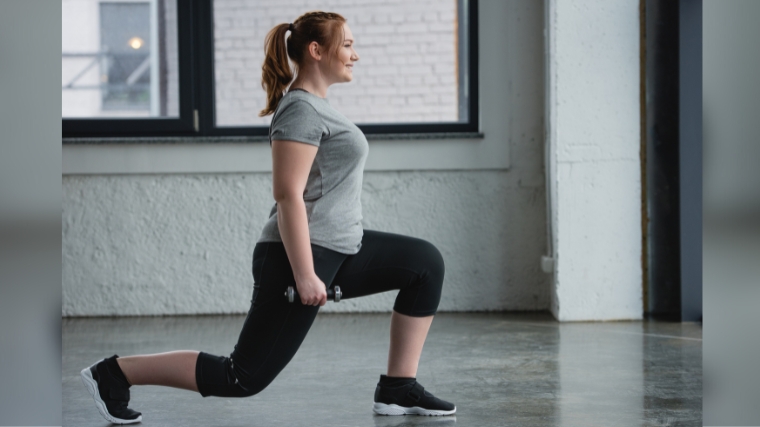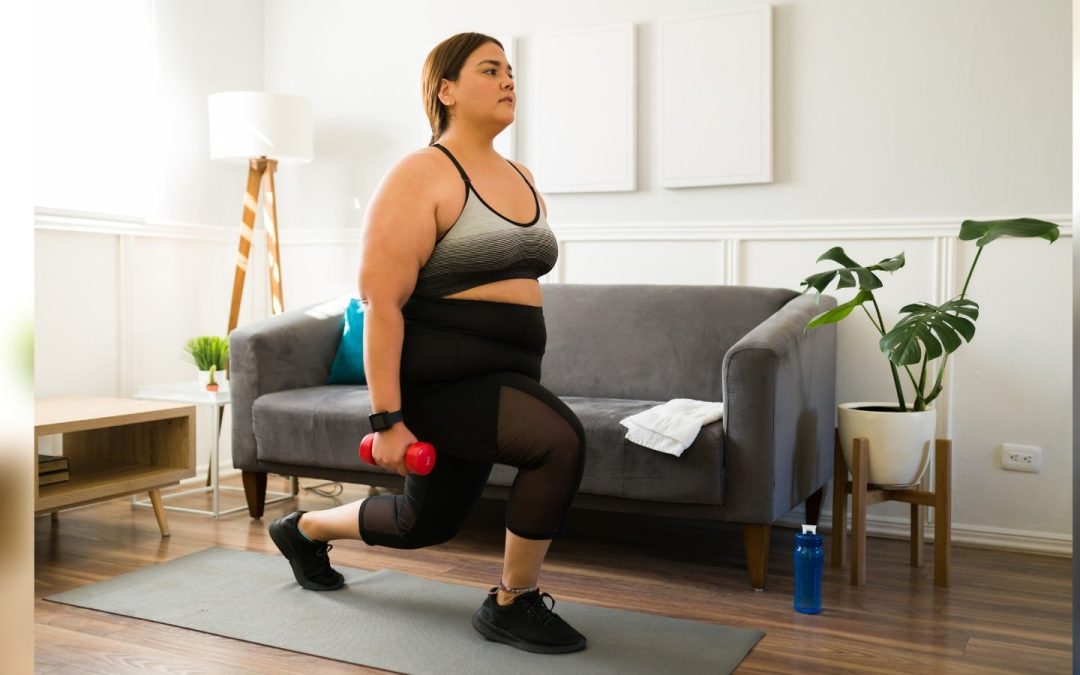When it’s time to train your lower body, barbell back squats get plenty of attention, but single-leg training should spend more time in the spotlight. In particular, it’s worth focusing on the dumbbell split squat to bring awareness to the staggered position and learn to coordinate weight distribution across both feet.
The dumbbell split squat, sometimes referred to as a static lunge, is performed in a split (or staggered) stance similar to a lunge position. Unlike the lunge, your feet won’t leave the floor during a split squat. This provides a little stability during a relatively less stable exercise

Here are a few different ways to work on the dumbbell split squat, along with variations, tips, and cues to get stronger at this single-leg focused movement.
Dumbbell Split Squat
- How to Do the Dumbbell Split Squat
- Dumbbell Split Squat Mistakes to Avoid
- How to Progress the Dumbbell Split Squat
- Benefits of the Dumbbell Split Squat
- Muscles Worked by the Dumbbell Split Squat
- How to Program the Dumbbell Split Squat
- Dumbbell Split Squat Variations
- FAQs
Split Squat Demonstration Video
Coach Morit Summers demonstrates a bodyweight split squat. The overall technique is identical to the dumbbell split squat, with the exception of the added resistance from a dumbbell in each hand.
How to Do the Dumbbell Split Squat
The dumbbell split can serve as your introduction to single-leg training. But even if you’re experienced with squats, lunges, and everything in between, this movement can be a great way to focus on each leg for more size and strength.
Step 1 — Begin Kneeling
Get on the ground in a half-kneeling or “proposal” position. Set your front foot flat on the floor with your knee bent at 90-degrees. Rest your back knee on the ground with your toes curled under, aimed into the ground. Hold a dumbbell in each hand with your arms straight by your sides.

Form Tip: You could start the exercise from the top, in a standing position, but the strength of a split squat comes from establishing a great half-kneeling position and initiating the movement with strong legs. The bottom position also helps to set up a powerful, stable stance by creating a good front knee angle.
Step 2 — Drive Up to Standing Position
Grip the weights and pull your shoulders back. Drive through the ground with both feet and reach a standing position at the top. Keep both of your feet connected to the ground. Your front leg should lock nearly straight. When standing upright, your rear leg may remain slightly bent depending on your leg length.

Form Tip: Be sure to keep your front foot flat on the ground and don’t allow your front heel to rise up. If your front leg doesn’t fully lock out straight, that’s okay. Your leg length and mobility will be influencing factors. Focus on raising your hips toward the ceiling, not pushing backward to “lockout” your leg.
Step 3 — Lower Under Control
Reverse the motion with focus and control. Think about driving your hips back to bend your front leg. Bring your back knee toward the ground. Allow your upper body to slightly lean forward at the waist while your arms remain aimed straight down.

Form Tip: Avoid resting your knee on the ground in the bottom position. Lightly graze the floor with your back knee to get a full range of motion.
Dumbbell Split Squat Mistakes to Avoid
Some single-leg exercises can be tricky for lifters to master, either due to balance and stability issues, or muscular differences between each leg, or other factors. Here are some of key issues to watch for.
Feet Placed Too Narrow
Starting with your feet too narrow, or nearly in line with each other, will make balance a major obstacle. Imagine trying to walk on a balance beam that’s three inches wide compared to one that’s a foot wide.
In the starting position, get your feet roughly hip-distance apart. This will help provide a more stable base, so you can focus on working your leg muscles instead of fighting to stay balanced.

Avoid it: One benefit of starting the exercise from the half-kneeling position is that you can test your balance before the lift begins. Find stability in a staggered position with your feet placed properly. When you feel balanced in the half-kneeling position, then you can begin the set.
Raising Your Front Heel
Another way some lifters sabotage their balance is letting their front heel come off the ground when lowering themselves into the bottom position. This makes the stability of your ankle joint much more of a weak point than the strength of your relatively larger leg muscles. In fact, heel-raised exercises are used specifically to target the smaller ankle stabilizers and achilles tendon. (1) It’s not an efficient way to target hips, glute, and thigh muscles.
Avoid it: Imagine the sole of your shoe glued to the floor. Drive your hips back when raising or lowering your body. Keep your whole foot grounded and focus on applying force through your full foot, not just the ball of your foot.
Torso Stays Too Upright
Any squat or lunge, as well as the dumbbell split squat, should still have a degree of hip hinge or bending at the waist. Keeping your upper body too vertical can limit muscle recruitment in your lower body by not allowing your hips and glutes to fully activate.
When you stay upright, you may also feel more pressure or weight distribution around your knees instead of in your hips. Over the long-term, this may cause unnecessary strain on your knee joints.

Avoid it: Don’t try to keep your shoulders squared over your hips throughout the exercise. Keep your spine neutral, not rounded, but lean your shoulders slightly over your front thigh. Allow your hips to drive back, which will encourage your torso to naturally lean forward as you go into the bottom of the movement.
How to Progress the Dumbbell Split Squat
Beyond the most common methods of adding weight and/or increasing repetitions, the dumbbell split squat can be modified by manipulating tempo (rep speed), altering the range of motion, or deliberately adding instability.
Tempo or Rep Speed
Altering tempo is a great first step to progressing the dumbbell split squat. Tempo is just another word for the speed of each repetition. By specifically decreasing the speed you lift and lower your body, you are spending more time under tension, which can trigger more muscle growth. (2). Taking three to five seconds to rise into the top position and another three to five seconds to reach the bottom can be a high intensity way to train.
Moving with slower, more controlled movements is also a great way to be connected to an exercise and really focus on technique. This can help you avoid momentum and zone-in on muscle recruitment.
Adjusted Range of Motion
By adding blocks, steps, or stacked weight plates, you can change the range of motion, which can increase or decrease the difficulty. Adding elevation under your front foot, your back foot, or both feet will increase the range of motion and make the dumbbell split squat harder. This will create a much larger stretch on your leg muscles while you are sitting into the bottom position and there will be more work in the eccentric (lowering) phase of the movement.
Adding something under your back knee will limit the range of motion and make the exercise less challenging. This is an effective modification if you have limited hip mobility because it helps to restrict the amount of stretch needed throughout the exercise.
Added Instability
Adding an element of instability will also challenge your nervous system which has its benefits as well. You can place a foam pad or thick-folded towel under your front foot to provide more of a stability challenge.
If you don’t have that equipment, you can instead set up with a narrow stance. While that was previously listed as a potential mistake, it can be used intentionally — only after you’ve mastered the basic movement — to add variety and increase the challenge without using heavier weights.
Benefits of the Dumbbell Split Squat
Many people overlook the benefits of single-leg training, including the dumbbell split squat, and overfocus on bilateral (two legged) squat variations. Here’s why you should incorporate the dumbbell split squat into your training program.
Single-Leg Power, Strength, and Size
It’s important to do unilateral lower body training work, including the dumbbell split squat, to address each leg individually. Traditional squats are a well-respected classic for a reason, but they are bilateral movements working both legs simultaneously. This can make it easy to compensate with your stronger leg when you are squatting — and every body has one leg slightly stronger or more developed than the other. With two-legged squats, your hips are squared off and your feet are planted symmetrically with a much more even base of support.
When you do a dumbbell split squat, you are changing your base of support, which then challenges your center of gravity, core stabilizers, and it changes the way your hips will work together. Single-leg training is also shown to possibly help reduce the risk of lower body injuries and improve power output compared to two-legged squatting. (3)(4)
Muscles Worked by the Dumbbell Split Squat
The dumbbell split squat prioritizes most of the lower body muscles while also recruiting your upper body to stabilize and control the weight.
Quadriceps
Your quadriceps, or quads, are your front thigh muscles. These work to extend and lockout your leg as you rise into the top position. Your quads are generally considered the primary muscle during the dumbbell split squat.
Glutes and Hamstrings
As hip extensors, your glute and hamstring muscles work together to bring your lower body into alignment with your upper body. These muscles are put into a significant stretch in the bottom position of the dumbbell split squat, and they are activated to initiate the rise upward.

Allowing your upper body to lean forward during the hip hinge motion will more significantly recruit your glutes during the exercise.
Abductors and Adductors
Your abductor (“outer thigh”) and adductor (“inner thigh”) muscles work to stabilize your legs and control any side-to-side knee movement during the dumbbell split squat. These muscles are constantly firing during the exercise to prevent your knees, particularly your front knee, from either caving in or shifting to the outside.
How to Program the Dumbbell Split Squat
Everyone’s individual goals and programming needs are different. The thing that matters most is getting the right exercises throughout a training program to help you feel as strong as possible. However, there are some “best practices” that can help to efficiently fit the dumbbell split squat into your current training plan.
After Bilateral Exercises
Generally, it’s more effective to do bilateral movements before unilateral movements because you can have more focus on the bigger lifts and you can potentially use more weight before fatiguing your muscles with unilateral training.
For example, do dumbbell split squats either during leg day or as a part of a full-body workout after doing several sets of front squats. Performing the exercises in the opposite order — with dumbbell split squats before front squats — will take energy away from the potentially heavier lifting which can affect progress in the long-term.
Light to Moderate Weight, Moderate Repetition
The dumbbell split squat isn’t an exercise that allows the use of very heavy weights because your grip, core, and upper back will be the weak link before you can target your relatively stronger leg muscles. So it’s best to use a weight that allows a moderate amount of repetitions. Aim for two to four sets of eight to 15 repetitions per leg.
Dumbbell Split Squat Variations
Once you’ve learned the basic dumbbell split squat, or if you’re looking for a “similar but different” single-leg exercise, there are a few top choices to consider.
Bulgarian Split Squat
The Bulgarian split squat might be all the rage with influencers on TikTok, but this rear-foot elevated movement was around long before social media. Having your back leg at a higher elevation increases the focus and muscular stress on your front leg.
A bulgarian split squat is a great example of progressing the basic dumbbell split squat by increasing range of motion while also adding instability — having your rear leg perched on a bench is less stable than keeping it flat on the floor. If you want to get really cruel, you can adjust the tempo and take several seconds for each phase of the repetition.
Dumbbell Step-up
Step-ups are another great option for single-leg training. The can be performed alternating legs with each repetition, which can give more of a cardio-type training effect, or by performing all reps with one leg at a time, which increases the time under tension and can trigger more muscle growth.
The step-up still focuses on using a good hip hinge while performing single-leg work. It’s more dynamic than the dumbbell split squat and can even be performed almost explosively with power, exploding into the top position, for greater strength and athleticism.
Frequently Asked Questions
Why do I topple over or feel unstable during the dumbbell split squat?
The exercise is a single-leg movement, so your base of support is reduced compared to more familiar two-legged squatting. Focus on staying connected to the ground when you’re training with a smaller base of support.
During the dumbbell split squat, push your feet into the floor and focus on using your hips. It is always okay to hold onto something stable for external support, like the back of an incline bench, to get used to the single-leg movement.
Are dumbbell split squats bad for my knees?
Unless you have a reason, like a pre-existing condition or specific doctors’ orders, that you shouldn’t be working through full range of motion with lower body training, then bending your knees and building strength and stability in the surrounding muscles is probably one of the most important and beneficial things you can do for general knee health and longevity.
References
- Andrew Revak, Keith Diers, Thomas W. Kernozek, Naghmeh Gheidi, Christina Olbrantz; Achilles Tendon Loading During Heel-Raising and -Lowering Exercises. J Athl Train 1 February 2017; 52 (2): 89–96. doi: https://doi.org/10.4085/1062-6050-52.1.04
- Burd, N. A., Andrews, R. J., West, D. W., Little, J. P., Cochran, A. J., Hector, A. J., Cashaback, J. G., Gibala, M. J., Potvin, J. R., Baker, S. K., & Phillips, S. M. (2012). Muscle time under tension during resistance exercise stimulates differential muscle protein sub-fractional synthetic responses in men. The Journal of physiology, 590(2), 351–362. https://doi.org/10.1113/jphysiol.2011.221200
- Speirs, Derrick E.1,2; Bennett, Mark A.3; Finn, Charlotte V.4; Turner, Anthony P.2. Unilateral vs. Bilateral Squat Training for Strength, Sprints, and Agility in Academy Rugby Players. Journal of Strength and Conditioning Research 30(2):p 386-392, February 2016. | DOI: 10.1519/JSC.0000000000001096
- Ramirez-Campillo, Rodrigo & Burgos, Carlos & Henríquez-Olguín, Carlos & Andrade, David & Martínez, Cristian & Álvarez, Cristian & Castro-Sepulveda, Mauricio & Marques, Mário & Izquierdo, Mikel. (2015). Effect of Unilateral, Bilateral, and Combined Plyometric Training on Explosive and Endurance Performance of Young Soccer Players. The Journal of Strength and Conditioning Research. 29. 1317–1328. 10.1519/JSC.0000000000000762.
Feature Image: antoniodiaz / Shutterstock

